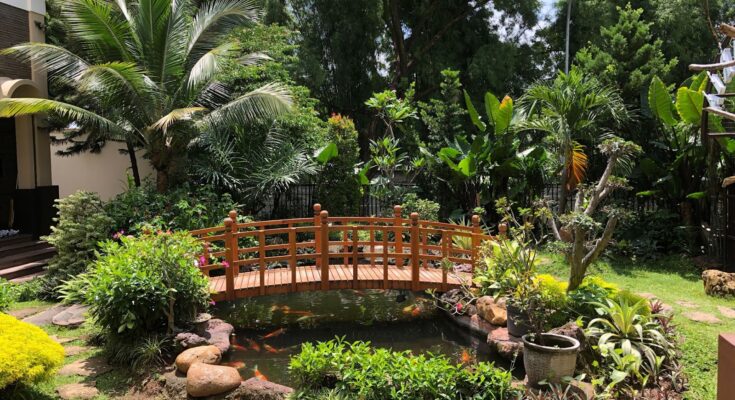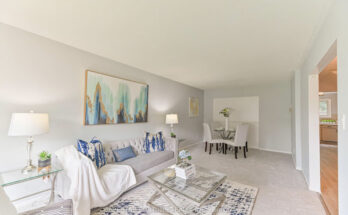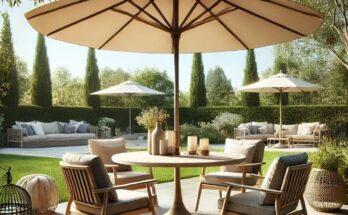A backyard pond is an enchanting addition to any outdoor space, offering a sense of tranquility and natural beauty.
Whether planning to create a new pond or revamp an existing one, thoughtful landscaping can elevate its overall aesthetic. By combining creativity with practicality, you can transform your pond into a picturesque oasis that captivates both your senses and visitors.
- Consider the Overall Design Ideas
Before diving into specific pond landscaping ideas, it’s important to determine the overall design style you want to achieve.
Do you prefer a formal, structured look or a more natural, organic ambiance? Consider the existing elements in your outdoor space, such as surrounding vegetation, architectural features, and the size and shape of the pond. A well-integrated design will create a harmonious balance between your pond and its surroundings.
Also, are you considering putting animals into the pond? It’s important to note that koi fish generally should not be placed with other wildlife. Avoid koi fish if you want to create a wildlife pond that includes frogs, newts, and other animals. Additionally, transferring koi fish, plants, and frog eggs between ponds can cause disease and introduce problem plants. So, avoid that at all if possible.
- Choose the Right Plants
Selecting the right plants is crucial for a visually appealing pond landscape.
Aquatic plants, such as water lilies, lotus, lily pads, and water hyacinths, add elegance and color to the water’s surface. Marginal plants, like irises and rushes, thrive in shallow water areas around the pond’s edge.
Additionally, tall grasses and ornamental shrubs can provide privacy and serve as a backdrop for the pond. Ensure you choose plants suitable for your climate and the specific conditions of your backyard or pond.
To create visual interest, incorporate a variety of plants with different textures, heights, and bloom times. Combine floating plants with submerged plants and emergent plants to add layers of depth and dimension to your pond.
Also, consider the seasonal changes in foliage and blooms to ensure year-round beauty. Try grouping surrounding plants in clusters or along the pond’s edges to create a more natural and harmonious appearance.
- Add Stone Elements
Hardscaping elements, such as rocks, boulders, and pebbles, add texture, structure, and a sense of permanence to your pond landscape.
Strategically place larger rocks around the pond’s perimeter to create a natural-looking shoreline. Smaller rocks and pebbles can be used to line pathways or accentuate the edges of flower beds. Remember to choose stones that complement your outdoor space’s overall design style and colors.
- Enhance with Lighting
The right lighting can dramatically transform the ambiance of your pond, especially during the evening hours. Install soft, warm lights strategically around the pond to highlight key features and create an inviting atmosphere.
Consider underwater lighting to illuminate the water, showcasing the beauty of your aquatic plants and the mesmerizing reflections. Use solar-powered or low-voltage LED lights for energy efficiency and ease of installation.
- Incorporate Water Features
Water features add an extra touch of elegance and serenity to your pond. Consider incorporating a small waterfall, a bubbling fountain, or a gentle stream into your design. These features create soothing sounds and enhance the visual appeal of a minimalist pond by adding movement and dynamic energy to the landscape.
- Provide Seating and Viewing Areas
To fully enjoy the splendor of your pond, create seating and viewing areas nearby. Install benches, deck chairs, or a cozy patio to allow you and your guests to relax and admire the beauty of your creation. Consider the positioning of these areas to optimize the views and ensure they are integrated seamlessly into the overall landscape.
- Have Caution with Fertilizers and Chemicals
Use caution when using chemicals and lawn fertilizers near the pond.
They can run off when it rains or if you water your lawn. This could contaminate the pond or kill fish. Form a ridge of about 3 inches around your pond to protect it from runoff. If the pond has an inclined surface, you can create a shallow, sloping channel to divert water runoff.
- Avoid Tap Water
If you use tap water to fill your pond or top it off, it will cause excessive algae growth and make it murky green. Instead, use rainwater.
There is no need to worry about the water level in your pond fluctuating, especially in summer. Rainwater can be collected in buckets, water butts, or other containers to top off your pond.
Final Thoughts
Applying these tips and ideas for pond landscaping lets you transform your outdoor space into a captivating oasis that exudes tranquility and beauty.
Remember to choose plants, hardscaping elements, and lighting that harmonize with your overall design style. With careful planning and a touch of creativity, your pond and garden will become a mesmerizing focal point that brings joy and relaxation to all who visit your outdoor sanctuary.




